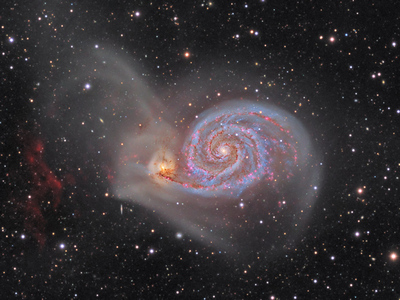|
While it is necessary to use quite large telescope under dark sky
to see its spiral structure by eye (Earl of Rosse, who discovered it
in 1845, used a telescope with 1.8 m bronze primary mirror), spirals are revealed
quite easily when the galaxy is captured with sensitive digital
camera. This makes the galaxy quite popular among
astro-photographers.

But the M51 image presented above is definitely not “just
another M51 image”. Fabian Neyer combined almost 147 hours of exposures taken with G3-16200 CCD camera
and C3-61000 CMOS camera on the TEC 140 APO refractor to create it.
The result is an incredibly deep and detailed image, revealing not
only the galaxy structure in unprecedented details, but also many
background galaxies, dark interstellar clouds belonging to our own
galaxy and especially hydrogen cloud, shown in deep red Hα line to the left of the M51, which probably
originated from the merger of both galaxies. Capturing of this
extremely faint cloud is a rare feat (it is simply missing on majority
of M51 portraits).
| 